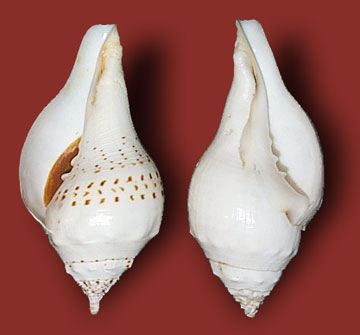
Conch Shells
Laxmi - Vishnu and other conches
last updated 7th September 2010

Samkha - The Sacred Conch Shell
Excerpt from Sri Navaratna Museum of Natural Wonders
An interesting background on the shankh industry in South India, and
the history of it...
http://www.hindunet.org/saraswati/chank/salsakwa.htm
Purchase your own Valampuri Shankh
More about sacred Dakshinavarti (Valampuri) Shankha's here:
The Sacred Chank of India (Book)
(pictures yet to come)
(1)
Intimately associated with the salagramas are the sacred conch-shells known as samkhas, which are also geological and biological specimens of great antiquity. Like the salagramas which are ammonite fossils, the samkhas are marine fossil remains of the large gastropods (stomach footed), especially ‘strombus gigas’. They are shells of bivalve mollusc (conchifera division of the molluscs). Molluscs are animals of the sea-shore, with soft bodies devoid of any bones but having hard shells. The gastropods crawl along on a broad foot (viz., stomachs) carrying shells on their bodies; and into these shells they pull themselves when threatened. Different molluscs have different plans in making their shells, like the moon-shells, cowry-shells, tooth-shells and ordinary bivalves (Lamelli-branchiata) like oysters. Conchifera (the spiral prominent mussels (cavities), with conchi-spires on the outside.
Since 1776, a separate discipline known as Conchology has grown for the study of conch-shells. In 1828, and instrument known as Conchometer was also designed to measure the spiral arrangements on the fossil–shell, the angles of the spire, and so on.
Since antiquity these marine shells have been credited with mystic ort occult powerk,k even in Greece and Rome. The Greeks, for instance, are known to have held in great reverence conchites, which were stones resembling the fossil-shells (conches). The conch-shells have also been employed since ancient times as a martial instrument. The conch-shell is perforated at one end, and blown as a wind-instrument, as a horn or trumpet. The use of these shells to announce the commencement of an encounter on the battlefield has been mentioned in the great epic Mahabharata. In Bhagavad-gita, the loud roar of the conch-shells blown by the Pandava army is said to have unnerved the Kauravas (1:19). The Romans and Tritons are also recorded to have used the trumpet like the Indian heroes. They also had their own names given to their favourite conch-shells.
In Bhagavad-gita, we read that Krsna’s conch-shell was named ‘Panchajanya’, Arjuna’s ‘Devadatta’, Bhima’s ‘Paundra’. Yudhisthira’s ‘Ananta-vijaya’, Nakula’s ‘Sughosha’ amd Sahadeva’s “Mani-pushpaka’ (1:15-16). Each of the other prominent warriors (Dhrshtadyumna, Satyaki, Sikhandi, Drupada etc) had his own conch-shell trumpet. The loud sound from the conch-shell is described as ‘ghosha’, ‘samkha-rava’, or ‘samkha-svana’.
In India, a conch-shell horn is regarded as one of the classical pentad of musical instruments (pancha-vadya) of folk character : horn (srnga or kombu), kettle-drum (tammata), conch-shell trumpet (samkha or davala), large drum (bheri) and bronce gong (jayaghanta or jagata). The conch-shell trumpet can be very melodic and is employed in processions and on auspicious occasions. There are two ways of blowing it : (1) dhamana or blowing by holding the perforated end directly to the lips, and (2) purana or filling the air-current into the conch-shell through a small cavity in the shell (symophonic).
The conch-shells in ancient maritime civilizations have also been used as containers of articles like oil and salt; the conch-shells have provided material and form for ornaments like bracelets and armbands (samkha-valaya), ear-pieces (samkha-patra), and necklace-beads (samkha-mani).
The convolutions of the conch-shell (the spiral curves) have inspired a large number of designs and decorative motifs. In Rome, an architectural style was modelled after the shell-convolution: domed roof with semi-circular apse. The spiral forms in art and architecture have directly been taken from the conch-shell.
And in religious lore, especially in Buddhism, it is one of the eight auspicious signs (astha-mangala), the other seven being a parasol (chhatra), vase (kalasa), flower (pushpa), the sacred knot (granthi), wheel (charka), banner (Pataka), and a pair of fish (mina). The conch-shell here symbolizes the dharma-teaching (dharma-smakha), even as the parasol stands for the divine protection, vase for immortality, flower for mercy, knot for eternity, wheel for truth, and banner for victory.
The form of the conch-shell is imitated in a particular hand-gesture (mudra) employed in classical dance as well as in ritualistic worship. It is known as ‘samkha-mudra’, belonging to the ‘samyuta’ variety (where both the hands are used together). The right thumb is placed in the middle of the left palm, and the left thimb is raised in the sikhara-manner (like the superstructure on the sanctum in a temple), while the other four fingers of the left hand engfold the right thumb. The four fingers of the right hand are enclosed in the left fist, the tip of the right fore-finger touching the tip of the upraised left thumb. The hand posture resembles the conch-shell convolution (samkhavarta). In the religious context, it symbolizes the presence of a conch which is dear to Vishnu.
Samkha in Indian mythology is also the anme given to one of the nine treasures held by the god of wealth, Kubera. It represents a bundred billion (or 100,000 koti or crore). An attendant of Kubera is called Samkha-nidhi, and he is shown as a corpulent dwarf in an easy posure holding a conch-shell in one of his two hands. His companion is Padma-nidhi, who resembles Samkha-nidhi in all particulars except that he holds a lotus in his hand instead of conch-shell. Another attendant of Kubera bears the name Samkha-chuda (or Samkha-sirsha), which is also the name of a dragon (naga).
The conch-shell motif is employed for branding cows and buffaloes (samkha-mudrankana). The branding seal is a small metallic plate carrying the cut-out design of a conch-shell (or of a discus, charka), with a handle. It is a curative device that branding is done, when the animals are ill. More often, the conch-shell is sued for pouring out libations of water (samkhodaka_ before an icon; or for giving a ceremonial bath to a monarch (samkha-snana).
(2)
The Sanskrit word “Samkha’ has the tymological meaning of pacifying the inauspicious (sam, Unadi-sutra, 1:104, ‘samyati asuubham asmat’). It is most characteristically associated with Vishnu, and is one of the four ‘ayudhas’ (literally ‘weapon’, but employed in the sense of whatever is held in the hand) usually found in his hands; the discus (chakra), the mace (gada) and the lotus (padma) being the other three. The conch held by Vishnu is named Panca-janya, even as the discus in his hand is Sudarsana and the mace Kaumodaki. Among the other weapons in Vishnu’s hands, the bow is called Sarnga and the sword Nandaka.
There is a legend which associated the conch-shell with Vishnu. The conch-shell is supposed to have appeared on earth from the bones of a demon called Samkha-chuda. Owing to a curse from Radha (in Goloka), the chief of Krishna’s attendants (parshada), whose name was Sudama, had to be born on the earth among mortals. He took the form of a mighty monster, who was lustrous and pompous. He. However, performed austerities in the Badari-hermitage on the Himalayan ranges, and obtained from Brahma the boon of an invincible armour (kavacha). The armour would without fail protect his life, until the armour was damaged, and the armour would be damaged only when the chastity of his spouse was violated.
This was sufficient assurance and encouragement for the wicked titan, whose new name was samkha-chuda, and he began tormenting the three worlds. No one knew how this formidable giant could be overcome; and even the gods were unable to encounter and contain his attacks.
This story, given in Brahma-vaivarta-purana (Prakrtikhanda), brings out the close relationship that obtains between salagrama stones, tulasi leaves and the conch-shell. There are slight variations in the story, as for instance, in Padma-purana, where Samkha-chuda and Tulasi become Jalandhara and Vrnda. But the involvement of Vishnu in the story is prominent, and the prohibition against the use of conch-shell in the worship of Siva is explained by the fight that Samkha-chuda had with Siva and the subsequent assassination of Samkha-chuda by Siva. The conch-shell is sacred for all other gods, and it especially signified the presence of Lakshmi, the goddess of wealth and prosperity.
The conch-shells are of many kinds, because the boes of Smakha-chuda’s body were of many shapes. Water in the conch-shell is dear to all the gods (except Siva), and is extremely holy. Whoever is bathed with the water from the conch-shell has the merit of taking a bath in all sacred streams in the country. In the conch-shell dwells Vishnu, and wherever the conch-shell is, Visnhu too is there; and there resides Lakshmi, warding off all evil.
This is also why the conch-shell which is used in worship is never placed on the unconsecrated ground. It is always kept on a special seat, known as ‘samkhadhara’. It is usually a metallic tripod, round in shape, with a hollow on top to accommodate and hold the bottom portion of the conch0-shell. It may have three or four legs (tripado va chatushpadah), lotus shaped (padmakaro) or triangular in shape (trikonah).
(3)
Salagrams are prescribed to be bathed in water or milk from the conch-shell; and tulasi leaves are then placed not only on the salagrama but on the conch-shell also. Before the worship of Vishnu begins, the conch-shell is duly installed (samkha-sthapana) and after the main worship is over, the conch-shell is now waved three times in front of the worshipped icon (samkha-bhramana) in order to eradicate the ill effects of the shadow of the icon (‘bimba=chhaya-dosha-pariharartham’). The conch-shell is filled with water, and the dhenu-mudra is assumed by the hands, while the eight-lettered mantra (om namo narayanaya’, ashtakshara) is recited. The first waving should be from the feet of the icon to the crown (padadi-mukuta-paryanta), the second from the navel to the crown (nabhyadi-nukuta-paryanta), and the third from the heart to the crown (hrdyadi-mukuta-paryanta). A verse is also uttered to signify that the water in the conch-shell (samhka-tirtha) has now acquired beneficial curative and protective properties.
The following translation of the Samkha-Sthapana-Vidhi in Meru-Tantra describes the several sequences involved in the installation of the conch-shell during the worship-ritual.
The procedure for the installation of the conch-shell during the worship ritual, which is itself a minor ritual, is given in the texts like Meru-tantra. The procedure is more or less uniform in the several cultic traditions.
After the installation of sacred pot (kalasa-sthapana), the sacred conch-shell must be installed for purpose of worship. The procedure is called ‘Samkha-sthapana’. The conch-shell must be located to the right of the kalasa and to the left of the worshipper.
1. The earth (ground) must be sprinkled with consecrated water (argha-jala), and a mandala involving triangular, square and circular shapes must be dram with matsya-mudra. While doing this, ‘astraya phat’ is to be recited.
2. The mandala drawn is worshipped with sandal-paste and flowers (gandha-pushpa);
and then the area is protected with the utterance of ‘phat’ after worshipping
the agneya-corner of the mandala and the other directions with ‘shadanga-mantra’.
3. The conch-shell-seat (samkhadhara) is then placed on the mandala. The conch-shell seat is a metallic one standing on three or four legs and circular, triangular or square in shape. It has a depression on top to receive the lower portion of the conch-shell. The mantra that is uttered while the seat is placed on the mandala takes this form ‘amuka (name of the deity is mentioned) devata-samkhadharam sthapayami namah’.
4. The conch-shell-seat is worshipped, along with the ten aspects (kalas) of fire in the circumambulatory order (pradakshinya-krama).
‘mam ram dharma-prada-dasa-kalatmane
vahni-mandalayam amuka-devata-samkhadharaya namah’
The ten aspects of the fire are worshipped as follows:
If one is unable to make these ten rounds of worship separately, he may recite ‘vahner dhumarchir adi dasa-kalarmane namah’.(i) yam dhumrarchishe namah
(ii) ram ushmayai namah
(iii) lam jvalinyai namah
(iv) vam jvalinyai namah
(v) sam vishphulinginyai namah
(vi) sham su-sriyai namah
(vii) sam surupayai namah
(viii) hum skilayai namah
(ix) lam havya-vahayai namah
(x) ksham kavya-vahayai namah
5. The the conch-shell is cleaned with water, reciting the mantra ‘phat’, and placed on the sea (adhara) meant for it, reciting ‘amuka-devata-samkham sthapayami-namah’.
6. The conch-shell thus placed is worshipped, visualizing in it the six-angled figure of earth (shat-kona bhu-bimba), and mentally adoring the six angles with the ‘shadanga-mantra’; the twelve aspects of the solar deity (‘suryasya dvadasa-kalah’) are worshipped beginning with the eastern direction and going in pradakshinya-order.
If, however, one is unable to recite the twelve mantras separately, he may recite ‘suryasya tapinyadi-dadasa-kalabhyo namah’.(i) kam bham tapinyai namah
(ii) kham vam tapinyai namah
(iii) gam pham dhumrayai namah
(iv) gham pam marichyai namah
(v) nam nam jvalinyai namah
(vi) cham dham ruchyai namah
(vii) chham dham sushumnayai namah
(viii) jam tham bhogadayai namah
(ix) jham tam visvayai namah
(x) nam nam bodhinyai namah
(xi) tam dham dharinyai namah
(xii) tham dam kshmayai namah
7. The seed-letters (matrka-varna) are then uttered in the reverse order, beginning with ‘ksham’, ‘ham’, ‘sam’, and so on, and ending with ‘am’.
8. The conch-shell is then filled with pure water and worshipped with sandal-paste, flower etc, reciting the mantra:
‘amuka-devata-samkham amrtena purayami namah’ and ‘um sam kama-prada-shodasa-kalatmane chandra-mandalaya namah’.
The sixteen aspects of the lunar orb mentioned here:
If one is unable to recite the mantras separately, he may recite ‘chandrasya-amrtadi-shodasa-kalabhyo namah’.(i) am amrtayai namah
(ii) am manadayai namah
(iii) im pushayai namah
(iv) im pushtyai namah
(v) um tushtyai namah
(vi) um ratyai namah
(vii) rim dhrtyai namah
(viii) rim sasinyai namah
(ix) lrm chandrikayai namah
(x) lrm kantyai namah
(xi) em jyotsnayai namah
(xii) aim sriyai namah
(xiii) om prityai namah
(xiv) aum angadayai namah
(xv) am purnayai namah
(xvi) ah purnamrtayai namah
The idea is that the sixteen vowels representing the lunar orb (chandra-mandala) symbolize the conch-shell, whereas the twelve groups of consonants representing the solar orb (surya-mandala) symbolize the seat of the conch-shell (samkhadhara).
9. Sandal-paste, flowers, conscrated rice, sesamum seeds, tips of kusa-grass and durva-grass, and sarshapa are offered to the conch-shell (viz. placed on the conch-shell), and the Tirtha is invoked from the solar orb with ankusa-mudra, reciting the following mantra:
‘gange cha yamune chaiva godavari-sarasvati
narmade sindhu-kaveri jalesmin sannidhim kuru’
To confirm this invocation of all the sacred streams in the water contained in the conch-shell, ‘vaushat’ is uttered, and flowers are put into this water. Galini-mudra is assumed and ‘vashat’ is uttered; assuming the dhenu-mudra, the water is transformed into nectar (amrti-karana).
10. The specific deity chosen for worship is then invoked to come out of the worshipper’s heart and reside in the conch-shell; while assuming the mudras of avahana etc., the water in the conch-shell is made wholesome (sakali-karana) by the shadanga-mantra, protected in all the directions by the astra-mantra, and covered by the kavacha-mantra. Finally, uttered ‘vaushat’, he looks at the conch-shell and assumed the sankha-mudra, and then places flowers, etc on the conch-shell. He worships his chosen deity; covers the conch-shell with his right hand, assuming matsya-mudra and recites the mula-mantra eight times.
(4)
The conch-shells that are worship-worthy are obtained on the sea coasts of Madras, Puri (Jagannatha), Ramesvaram and Sri Lanka. Broadly, there are two varieties: (1) those with right-ward convolution (dhaksinavarta) and (2) those with left-ward convolution (vamavarta). The former are said to be rare, and are supposed to occur in two sub-varieties (i) male (purusha), the conch-shells which have thick and coarse crust, and (ii) female (samkhini), the conch-shells which have thinner and finer crust. The right-oriented conch-shells called in Tamil ‘valam-puri’ and in Kannada ‘bala-muri’, are held exceedingly holy, and are themselves worshipped. Varaha-purana (the chapter on Prabhodhini-mahatmya) tells us that water from this conch when sprinkled on one’s head and sipped will eliminate all sins.
The latter (viz, left-priented ones) are more frequently found, as they occur abundantly on snady beaches. There is also a third variety, known as ganesa-samkha, which are extremely rare in the Indian sea-coasts. It is vermillion-hued on the outer surface as well as in the inner, and has a very short tail-end (quite unlike the usual conch-shells). Because of its rarity, it is also very costly in the market. Its shape resembles the basic form of Ganapati, the elephant-headed deity with the curved trunk; and hence its name.
There are conch-shells with different colouts (varna) and the colours are related to the classes (jati) of the people in our society. Accordingly, there is a classification of conch-shells into the Brahmana-variety (which are white in colour, smooth in texture and light), the Kshatriya-variety (red-coloured, or brown-hued, heavy, rough and course), the Vaisya-variety (yellowish in hue, glossy, thick and light) and the Sudra-variety (dull gray or dark brown in colour, hard and heavy).
This classification, however, is neither exhaustive nor accurate. The conch-shells that are available can never be accommodated in these four varieties. It is therefore more textual than actual. Most of the conch-shells are described as white (dhavala), some dazzling, some dull, some of mixed hue. But the preferred variety is milk-white (go-kshira-dhavala).
According to Skanda-purana, the sacred conch-shell must be dazzling white in colour, like cow’s milk, and must have a long neck and broad body; it must be long in the front portion. When blown, it should emit a long, loud and sonorous sound like ‘om’. On the back of it, there must be a long central line. The right convoluted shell is meritorious.
Not all forms of conch-shell obtained from the sea are suitable to be used in worship. They are all bivalve shells (sambula), and many occur in many colour. The wise folk will discern the acceptable characteristics (lakshana) in them. The good conch-shells are got only in some places, and not everywhere in the ocean.
If Skanda-purana lauds the left-oriented conch-shells, as all accomplishing, there are many texts like Samkha-kalpa, which claim that the right-oriented conch-shells are most auspicious and beneficent, and also that it’s worship will bring forth all bebefits.
The Skanda-purana (setu-mahatmya section) eulogizes the seaside in Ramesvaram in the extreme South and the neighbouring coastal regions, where good conch-shells are obtained. The main stretch of the sea caost for this purpose is said to be five yojanas. The text gives names to the conches obtained in different site: Paudra, where the river Kaveri joins the sea, Ananta-vijaya in the eastern coast near Somanath, Mani-pushpa in Agni-tirtha to the west of ramesvaram in the South, Su-ghosha in Samkha-tirtha in the region between the Vata (a collection of sixteen vata-trees in Vajra-mandala on the banks of the Yamuna) and the sea, Pancha-janya in Kusa-sthali (another name for Dvaraka, more particularly Chakra-tirtha), and Deva-datta in the region where the river Tamra-parni flows and the shrine to Sangamesvara is located. Of these varieties, the text says that Pancha-janya is the best.
Hari-vamsi (89:15-17) associated Pancha-janya with Vishnu, because Krishna killed the whale-demon called Pancha-jana in the seas, and the conch-shells were formed out of the bones of this demon )’pancha-jane daitya-visishe bhavah pancha-janyah’; ‘pancha-jano nama daityah samudre timira-rupa asit; tad asthi-jatam’ etc). Amara-Kosha gives Vishnu-samkha as the synonym of panch-janya. Sometimes, the name Pnacha-janya is given to a rare and freak formation of a conch-shell in which the cavity contains within it another smaller conch-shell attached to it. A specimen preserved in the Chamundesvari temple atop the hill in Mysore contains still another (third) conch-shell. All good samkhas are said to be pancha-janyas, and the standard verse eulogizing a conch-shell is therefore:
The conch-shell is said to have the preserve of all the gods and goddesses: Brahma on the seat (samkha-pitha or samkhadhara), Surya in the middle of the conch-shell, and Chandra at the tip. On the right side of the conch-shell are seated Aditya, Varuna, Soma, Vayu and Agni. Samkha is presided over by the twin gods Sun and Moon, and Varuna is it’s deity; at the back of the conch-shell is Prajapati, and in front the river goddesses Ganga and Sarasvati (Vaikhanasagama). So even to look at a conch-shell, or to touch it, would mean eradication of sins, like darkness disappearing on sunrise.
The bow before the conch-shell, holding it in the hand, and bathing the icon of Vishnu with water from the conch-shell, would secure endless merits.
Worship of Vishnu without the employment of conch-shell and without adoring it, would take away all the advantages of such worship; and this is the boon that Vishnu himself has bestowed on the conch-shell. Even before the worship of Vishnu commences, one should bow before the conch-shell and worship it briefly. This would secure the fulfilment of all desires and the obtainment of Vishnu’s own realm. Vishnu must be bathed in water through the conch-shell. The use of the conch-shell is prescribed in the worship of all the gods except Siva and Surya.

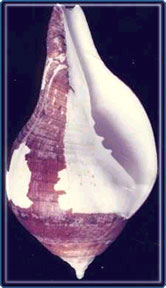
RARE LAKSHMI CONCH: Dakshin Shank: The Right-Spiralling Conch Shell
Conch Shells which spiral to the right are very rare and considered especially sacred, the right spiral mirroring the motion of the sun, moon, planets and stars across the sky. Also, the hair whorls on Buddha's head spiral to the right, as do his fine bodily hairs, the long white curl between his eyebrows and the conch like swirl of his navel. A shell is made into Tibetan ritual musical instruments by cutting off the end of its tip and furnishing it with a mouthpeace and an ornamental metal casing extending from the shell's mouth.
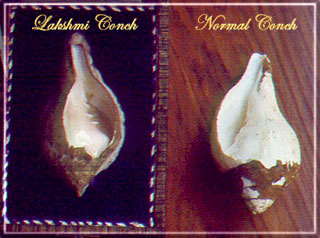
Cyber example pictured: 'Valampuri' Dakshin Conch & Normal Shank
Over the last 30 Years I have been looking for the truth about the fabled Lakshmi Conch Shell. It is priceless and NO ONE would ever sell one. They are so rare that only a few bog temples in India have them. I only found two, one in Pashupati Nath Temple Museum (Katmandu), and one in the London Museum of Natural History. In fact they are the same kind of Shank or Conch shell that we blow and bath the Deities with but they open on the right side (opposite of normal).
When shell collectors refer to the reversed Shank as “left-handed” or "sinistral", the Indians call the “valampuri” right-handed, because they orient it with the apical spire downwards and the aperture or siphon (mouth) uppermost and, consequently, on the right side of the shell.
Note: there are many species in Conch family, but in India "Shank" always refers to the normal smooth white conch shells we always use. They alone are called "Shank" --- and it is ONLY such a shell, if it opens on the right side, that is a real Lakshmi Shank. No other right-sided shell is ever Lakshmi Shank.
Also over the years I have visited many Krishna temples and seen that they spend, say Rs. 300 and buy some other kind of brown-reddish spiny, rough shell that opens on the right (Lightning Whelk) and THIS they mistakenly believe to be a Lakshmi Shank!?? They are wrong. There is ONLY one true Lakshmi Shank, and the photos above are a darshan of the REAL thing...
...and you won't get one for Rs. 300. or even Rs. 300,000.
So it is better to use a real left-handed white smooth shank, like normal, rather than another type of shell, like a Lightning Whelk, that is not even a Shank, and which is NOT recommended in Puja. Only a Shank is auspicious for puja, what to speak of a shank that opens on the right side, viz., A Lakshmi Shank.
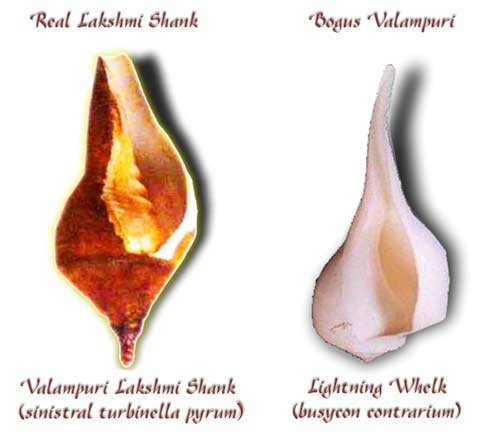

Left: Normal Conch - Right: Valampuri Shankha cleaned
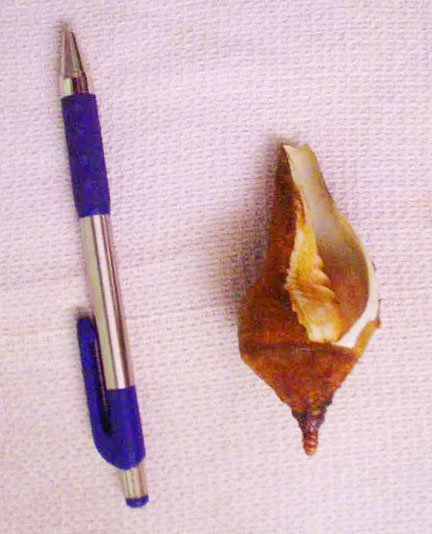
Footnote from Hrishikeshananda prabhu ACBSP:
The question about using an American Whelk shell
in Vishnu puja might be up-in-the-air because HDG made some comment, but
the fact that American Whelk is NOT Indian Shank, including Lakshmi Shank,
that is without a doubt a TRUE, just as much as taking a fossil from NZ
and calling it a Shalagram just because it had a chakra would be bogus.
I'm a gemologist. And it's a question of positive ID. It's either a RUBY or NOT. It's a Lakshmi Shank or NOT. It's a Govardhan Shila or NOT??? That is "sacred-gemology" (would you believe I coined the term, just like in 1979 I coined the term "Planetary Gemology" that is now popular term in Jyotish, I had a book then called "Handbook of Planetary Gemology", and over 3000 copies were sold to the TM people before they had a clue. Iskcon too, all 5000 were sold of that 1st edition)... So as a "Sacred Gemologist" I want the devotees to be knowledgeable so they don't look or act foolish.
And even consider price: a REAL (normal left side) Conch costs LESS than a Whelki. And Shank (not Whelk) is Shastric.
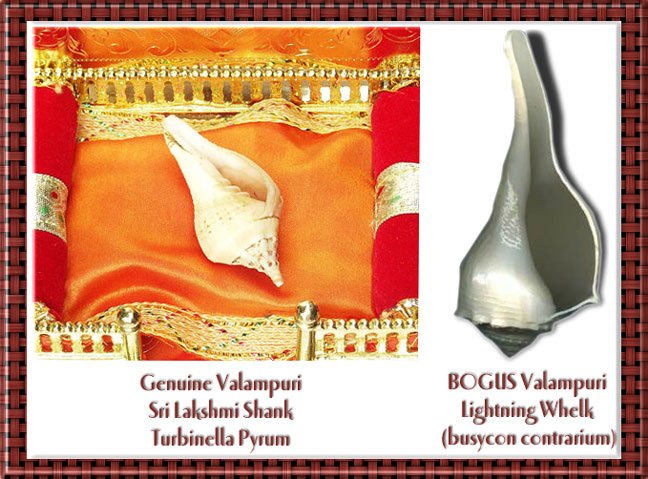
QUESTION: Most ISKCON temples have "Lightning Whelks" on the altar. I have heard from some that this is an accepted exception but I have very serious doubts. Any information about other kinds of sea shells besides conch shells. Maybe you could write a detailed article on the subject and I could circulate it to pujari types in ISKCON who should know the truth.
REPLY: Shastra says "bone" is impure, BUT, Conch Shell (Indian Turbinella Pyrum) is super-pure, even to bathe the Deities. Even Lakshmi Devi and Her Lord Narayana carry one in Their hand. Shastra doesn't say ANY SHELL or EVERY SHELL is pure, it's only Indian Shank (Turbinella Pyrum) that is pure. And these come in two types, normal left side opening AND special right side opening (Valampuri Dakshin-varti Turbinella Pyrum). Both are ruled by Goddess Lakshmi. It is not required to have right-side opening. Left side (normal) opening Shank is perfect for puja. And Lakshmi Shank is even better than perfect. It is said by Conchologists that only one Lakshmi Shank is found among 1,000 normal Indian Shanks. And ALL Indian shanks are pure and auspicious.
BUT common Lightning Whelk (busycon contrarium), with no internal formation and no ridges in the conch cavity - is a bogus non-pure shell. And as you mention so many temples use this non-conch shell, and they're doing puja with an impure non-conch shell simply because they have been hoodwinked by con men. It is embarrassing that temples use the wrong shell. And in many temples they openly display the fact that they have been cheated on a bogus Conch. And worse, they tell the public that they have a REAL Sri Lakshmi Conch, even though that is untrue.
Fact: The left side opening OR the right side opening Turbinella Pyrum Indian Conch - with 3 to 7 ridges in the conch cavity, and special internal structure is the ONLY Shank that is Vedic. The normal left-side opening Conch is very low price, even less than the bogus ones (Lightning Whelk), and only the Indian Shank is correct for puja.
Genuine Valampuri Lakshmi Shank Turbinella Pyrum Conch shells sell by
the gram. Normal size is about 60-120 grams. Depending on quality and number
of ridges in the conch cavity they sell for between Rs. 1,000 up to Rs.
3,000 per gram. This means that a genuine Lakshmi Shank can be had for
a few thousand dollars ONLY. So no one has any excuse to use a non-conch
shell. Everyone can use either a $2 normal Shank OR a $2,000 Lakshmi Shank.
BUT, USE A SHANK, ONLY!
The Dakshinavarti Shankha is also known as Lakshmi Shankha and Valampuri Shankha. This rare, highly auspicious and much coveted Shankha also belongs to the same species as the regular Shankha known as turbinella pyrum but opens to the left - sinistral. Hence this species is called sinistral turbinella pyrum. It is a genetic cousin of the regular Shankha - opening the other way. Hence the Valampuri can come in as many sizes, shapes and varieties as the regular Shankha. Some people who have bought just one Dakshinavarti in their life and might have seen a few pictures on the net talk like experts and start doubting these varieties and claim that each line or mark on a Valampuri is either a crack or glue or resin mark of a fake.
The true Dakshinavarti Shankha has the three or more horizontal lines at the inside center opening. The Valampuri is the favourite of Goddess Lakshmi and it is considered very auspicious to keep this Shankha in Pooja for all round prosperity. This is very difficult to get and the price is quite high and varies.
Please note that these Shankhas are caught by fishermen who dive into the sea and catch them. After that they sell them to major Shankha dealers. These Shankhas displayed on my pages are with my suppliers for whom my site is a selling medium.
Apart from displaying the Valampuries, the following are the services provided us:
a) A guarantee certificate with the actual picture attested and a clear
money back guarantee if proved tampered or fake.
b) X-ray of the Shankha.
c) Lab report of Shankha tested for contents.
d) Authenticity certificate by a highly qualified scientist who is
an Shankha expert.
So you can be 100% sure that each Valampuri is 100% tested.
The following are the genuine Valampuri Lakshmi Shankhas we can offer you.
Click on the Shankha picture to see bigger picture and size and price details.
(Opens in a new window)
Polished
Valampuris. 3 pieces
Jewel
Quality Valampuris. 2 pieces
Rare
Astha-Lakshmi Valampuris. 2 pieces
If you are interested in buying these rare items email > sptata@astrojyoti.com
Phone: 91-11-26680664, 91-11-26673281, 91-11-55763324, Mobile: 9911119235.
Om mahadevyai cha vidmahe vishnupatnyaicha dhímahi tanno Lakshmí
prachodayaat
Om Panchajanyaya vidmahe padma garbhaya dhimahi tanno Shankha prachodayaat
 If
anyone is desireous of purchasing their very own genuine Valampuri Laxmi
conch below are some dealers who can arrange that for you.
If
anyone is desireous of purchasing their very own genuine Valampuri Laxmi
conch below are some dealers who can arrange that for you.
Here are some genuine dealers. Buyer beware!!!
Please contact: Sahayji Fernando <valampuriimpex@gmail.com>
![]()
Please contact: SPS KATHIRAVAN
spskathiravan ravan <bb_22_72@yahoo.com>
Address: 106A DEPOT ROAD
#04-569
SINGAPORE 101106
Handphone cell/mobile: 0065-94243704
![]()
Fathima Trading Center <fathimatradingcenter@yahoo.fr>
BSYEDAHMED
Director
Fathima Trading Center S A R L
1er etage, Porte 10.
52 Avenu du parc
93290 Tremblay en france
FRANCE.
http://fathimatradecenter.tripod.com/
![]()
John Ravi <johnravi_135@yahoo.co.in>
![]()
John Ramnath <omegaa1@dataone.sancharnet.in>




